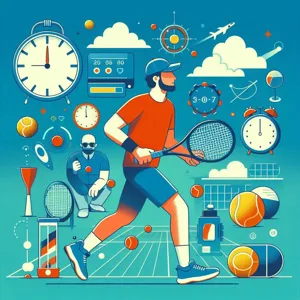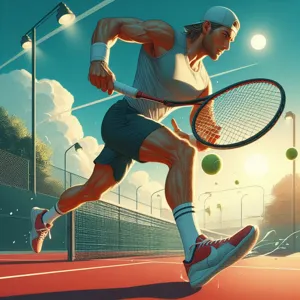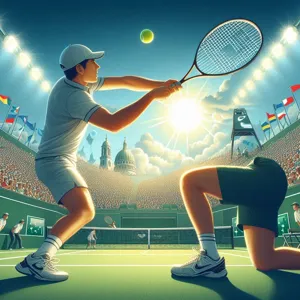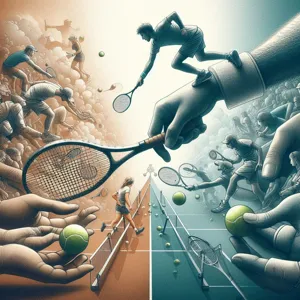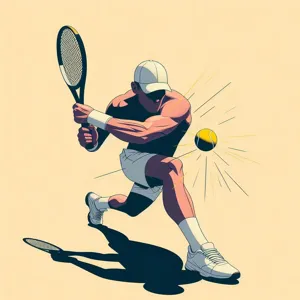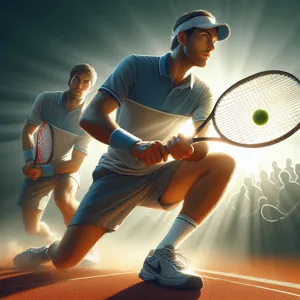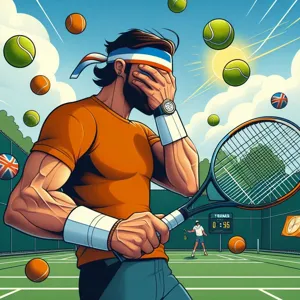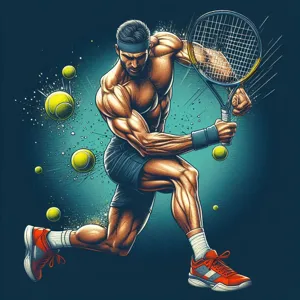In the world of tennis, physical prowess is only half the battle; the other half lies in the intricacies of the mind.
Mastering the mental game can be the defining factor that separates the good players from the great ones. Whether you’re a seasoned competitor or a weekend warrior, your mental resilience can determine how you handle pressure, overcome setbacks, and seize opportunities on the court. This blog post delves into essential strategies designed to elevate your tennis performance by sharpening your focus, boosting your confidence, and enhancing your ability to remain calm under pressure. From visualization techniques to mindfulness practices, we’ll explore the mental tools that can transform not only your game but also your overall enjoyment of tennis. So, grab your racket and prepare to unlock your full potential as we embark on this journey to mastering the mental aspects of the sport!
1. Understanding the Mental Game in Tennis
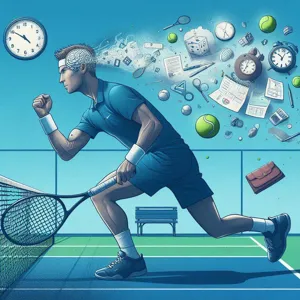
Tennis is often described as a game of inches, but what truly determines success on the court goes far beyond physical prowess. The mental game of tennis is an intricate blend of focus, resilience, and strategy, shaping the way players approach each match, point, and even practice session. Understanding this mental landscape is crucial for athletes looking to elevate their performance and gain a competitive edge.
At its core, the mental game in tennis encompasses the psychological strategies that players employ to navigate the pressures of competition. This includes developing a strong sense of self-awareness, which allows players to recognize their emotional triggers and manage their responses under stress. The ability to stay calm and composed during high-pressure situations—like facing a break point or competing in a tie-breaker—can dramatically influence the outcome of a match.
Moreover, visualization plays a key role in mental preparation. Successful players often spend time imagining themselves executing flawless serves, hitting accurate forehands, or celebrating a hard-fought victory. This mental rehearsal not only boosts confidence but also helps to solidify muscle memory, making it easier to replicate these successful actions on the court.
Equally important is the concept of ‘staying in the moment.’ Tennis is a game rich with ups and downs, and the best players know how to focus on the next point rather than dwelling on past mistakes or worrying about future outcomes. This mindfulness approach allows athletes to maintain their concentration and adapt their strategies in real-time, ultimately enhancing their performance.
By grasping the intricacies of the mental game, players can cultivate a mindset that promotes not only skill development but also emotional resilience. With dedicated practice and the right strategies, any player can improve their mental fortitude, paving the way for both personal and competitive success in the exhilarating world of tennis.
2. The Importance of Mental Toughness
In the world of tennis, where every point can swing the momentum of a match, mental toughness emerges as a crucial differentiator between good players and great ones. It’s not just about having the physical skills to hit a powerful serve or execute a perfect backhand; the mental game plays an equally pivotal role in determining success on the court.
Mental toughness encompasses resilience, focus, and the ability to maintain composure under pressure. It allows players to push through adversity, whether that means overcoming a challenging opponent, handling a tough crowd, or bouncing back from a string of lost points. Imagine being in the middle of a tense match, with your opponent gaining confidence and the crowd buzzing. In these moments, it’s your mental fortitude that will dictate your response. Will you crumble under pressure, or will you dig deep, summon your inner strength, and rise to the occasion?
One effective way to cultivate mental toughness is through visualization techniques. Picture yourself in various match scenarios—serving under pressure, winning crucial points, or recovering from a setback. By repeatedly visualizing these situations, you can train your mind to respond with confidence and clarity when faced with real-life challenges on the court.
Additionally, maintaining a positive mindset is essential. Developing strategies to combat negative self-talk can transform your performance. Instead of dwelling on mistakes, focus on what you can control: your effort, your attitude, and your next shot. Embrace the mantra that every match is an opportunity for growth, and remember that even the best players face setbacks.
Incorporating mindfulness practices can also enhance your mental toughness. Techniques such as deep breathing and meditation can help clear your mind, reduce anxiety, and improve concentration. By learning to stay present and focused, you can navigate the highs and lows of a match with greater ease, allowing your skills and instincts to take over.
Ultimately, mastering the mental game is about building a robust mental framework that supports your performance. By prioritizing mental toughness, you set the stage for consistent improvement and a deeper enjoyment of the sport. As you cultivate this aspect of your game, you’ll find that not only does your performance elevate, but your overall experience on the court becomes more fulfilling.
3. Visualization Techniques for Success

Visualization techniques are a powerful tool in the mental game of tennis, often overlooked by players eager to focus solely on physical training. By harnessing the power of your imagination, you can create vivid mental scenarios that prepare you for match situations, enhance your performance, and boost your confidence. Visualization involves more than just imagining the ball flying over the net; it’s about immersing yourself in the experience, engaging all your senses to create a comprehensive mental picture.
Begin by finding a quiet space where you can relax and focus. Close your eyes and take a few deep breaths to center yourself. Visualize the court you play on—the texture of the surface beneath your feet, the sound of the ball hitting the strings, and the feel of the racket in your hand. Picture yourself executing your favorite shots with precision and grace, whether it’s a powerful serve slicing through the air or a perfectly angled backhand that leaves your opponent scrambling.
Incorporate the emotions you want to feel during a match—confidence, determination, and focus. Imagine the crowd’s cheers or the scoreboard displaying your victory. This practice not only prepares you for the physical challenges ahead but also conditions your mind to respond positively under pressure. Regular visualization can help solidify muscle memory and reinforce successful outcomes, making them more likely to manifest when you step onto the court.
Don’t limit your visualization to just positive outcomes; consider also the challenges you may face during a match. Visualize scenarios where you may be down in points or facing a tough opponent, and mentally rehearse how you will respond to maintain composure and strategize your comeback. This proactive approach can diminish anxiety and increase your resilience, allowing you to face adversity with a calm and focused mindset.
Incorporating visualization into your daily routine, whether during a quiet moment at home or as part of your warm-up before hitting the courts, can set the stage for elevated performance. By mastering the mental game through visualization, you’ll not only enhance your skills but also cultivate an unshakeable belief in your ability to succeed, paving the way for a higher level of play and greater enjoyment of the sport you love.
4. Developing a Pre-Match Routine
A well-crafted pre-match routine is essential for setting the tone and mindset before stepping onto the court. This routine serves as your mental warm-up, helping to quell nerves, sharpen focus, and foster a sense of confidence that can significantly impact your performance.
Start by identifying the elements that best prepare you for competition. For some players, this might include a series of physical stretches or a brief jog to get the blood flowing, while others may prefer a more meditative approach, engaging in deep breathing exercises or visualization techniques. Imagine yourself playing at your best, picturing each stroke with precision and feeling the exhilaration of executing your game plan flawlessly.
Incorporating consistent rituals can also enhance your focus. Whether it’s listening to a specific playlist that pumps you up or reviewing a set of motivational quotes that inspire determination, these small yet powerful practices help to create a familiar mental landscape.
Timing is crucial in your pre-match routine. As you approach your match time, consider a structured sequence that allows for both physical and mental readiness. aim to arrive at the venue early, giving yourself ample time to engage in your routine without the stress of rushing. Don’t forget to include moments for hydration and nutrition—fueling your body effectively can be just as important as mental preparation.
Lastly, remember that your pre-match routine should be tailored to you. Experiment with different elements to discover what helps you achieve the ideal mindset. The more you refine your routine, the more confident and composed you will feel, allowing you to step onto the court ready to compete at your highest level. By investing time in developing a solid pre-match routine, you’re not just preparing for a match; you’re setting the stage for success.
5. Strategies for Managing Anxiety and Pressure

In the high-stakes world of tennis, managing anxiety and pressure is crucial for peak performance. The mental aspect of the game often determines the outcome as much as physical skill does. Players at all levels experience moments of doubt and pressure, especially during critical points in a match. However, developing effective strategies to cope with these feelings can make all the difference on the court.
**1. Breath Control:** One of the simplest yet most effective techniques is focused breathing. When anxiety creeps in, take a moment to pause and focus on your breath. Inhale deeply through your nose for a count of four, hold for four, and exhale slowly through your mouth for another four counts. This rhythmic breathing helps calm your nervous system and brings your focus back to the present moment, allowing you to refocus on your game.
**2. Visualization:** Visualizing success can be a powerful tool. Spend a few quiet moments before your match picturing yourself executing your shots flawlessly, feeling confident and composed throughout the game. Envision the scenario where you handle pressure situations with ease, whether it’s a match point or a crucial serve. This mental rehearsal prepares your mind to respond positively when the real situation arises.
**3. Positive Self-Talk:** What you say to yourself matters immensely. Replace negative thoughts with positive affirmations. Instead of thinking, “I can’t serve under pressure,” change it to, “I am capable and prepared for this challenge.” Cultivating a habit of positive self-talk can transform your mindset, helping you to approach pressure situations with confidence rather than fear.
**4. Routine Development:** Establishing a pre-match and in-match routine can provide a sense of control and normalcy in the chaotic environment of competition. This might include specific warm-up exercises, a particular way of preparing your equipment, or rituals before serving. A consistent routine can help ground you, making it easier to manage anxiety as you transition into the competitive mindset.
**5. Focus on the Process, Not the Outcome:** Shifting your focus from the final score to the process of playing can alleviate some pressure. Concentrate on executing each point to the best of your ability, rather than obsessing over winning or losing. By immersing yourself in the moment and enjoying the game, you can reduce the weight of expectations pressing down on you.
By integrating these strategies into your training and match preparation, you can cultivate resilience against anxiety and pressure. Remember, even the most seasoned players face these mental challenges, but with the right tactics, you can harness them to elevate your performance and enjoy the game more fully.
6. The Power of Positive Self-Talk
In the high-stakes world of tennis, where every point can swing the momentum of a match, the dialogue we have with ourselves can be just as crucial as our physical preparation. Positive self-talk serves as a mental coach, propelling you forward when doubts threaten to creep in. Instead of allowing negative thoughts to take root—thoughts like “I can’t believe I missed that shot” or “I’ll never win this match”—turn the narrative around. Reinforce your performance with affirmations such as “I’ve trained for this moment” or “I am capable of executing my game plan.”
The impact of positive self-talk extends beyond mere encouragement; it can alter your physiological response as well. When you engage in constructive self-talk, you reduce anxiety levels and foster a sense of control over your performance. For instance, before a crucial serve, telling yourself, “I serve well under pressure” can boost your confidence and help you focus on the task at hand rather than the potential consequences of failure.
To harness the power of positive self-talk, consider incorporating it into your daily routine. Start by jotting down affirmations that resonate with you, or create a mantra that encapsulates your competitive spirit. Repeating these affirmations during practice sessions can help ingrain them into your subconscious, making it easier to draw upon them during matches.
Moreover, visualize success as part of your self-talk strategy. Picture yourself executing a perfect backhand or celebrating a hard-fought victory. This mental imagery, combined with positive affirmations, creates a powerful synergy that can elevate not just your mindset but your overall performance as well.
Remember, the game of tennis is often as much about mental strength as it is about physical prowess. By prioritizing positive self-talk, you can build resilience, maintain focus, and ultimately enhance your performance on the court. Embrace this powerful tool, and watch as your game transforms from the inside out.
7. Building Focus and Concentration on the Court

Building focus and concentration on the court is essential for elevating your tennis performance. The fast-paced nature of the game demands not only physical skill but also a sharp mental acuity. To truly excel, you must cultivate the ability to stay fully present during matches and practice sessions, filtering out distractions that can derail your performance.
One effective strategy for enhancing focus is to establish a pre-match routine. This ritual can include visualization techniques where you imagine yourself executing your shots perfectly, feeling the rhythm of the game, and envisioning your success. By creating this mental image, you prime your mind for the challenges ahead, grounding yourself in a mindset of confidence and determination.
Another valuable technique is to employ mindfulness practices. This involves training your mind to concentrate on the present moment, whether it’s the feeling of the racket in your hand or the sound of the ball hitting the strings. Simple breathing exercises can help clear your mind, allowing you to channel your energy towards each point rather than dwelling on past mistakes or future outcomes.
Additionally, breaking the game down into smaller, manageable segments can help maintain your concentration. Instead of focusing on the entire match, direct your attention to just the next serve or the next point. This micro-focus approach can alleviate the pressure and help you stay engaged in the moment, enhancing your overall performance.
Lastly, practice makes perfect. Regularly engaging in drills with a focus on mindfulness can help develop your ability to concentrate over time. Whether it’s working on your serve or rallying with a partner, consciously practicing your focus will translate into improved performance during competitions.
By implementing these strategies, you can build a mental fortitude that not only enhances your focus and concentration but ultimately leads to greater success on the court.
8. Learning from Mistakes: Embracing a Growth Mindset
In the world of tennis, where split-second decisions can swing the outcome of a match, the ability to learn from mistakes is not just advantageous—it’s essential. Embracing a growth mindset transforms errors from a source of frustration into invaluable learning opportunities. This perspective allows players to approach their performance with curiosity rather than fear, viewing each misstep as a chance to improve rather than a setback.
When you miss a crucial shot or fail to execute a planned strategy, instead of dwelling on the failure, analyze it constructively. Ask yourself: What led to that mistake? Was it a lapse in technique, a mental distraction, or perhaps a misread of your opponent’s intentions? By dissecting these moments, you can create a personalized roadmap for improvement.
Journaling can be an effective tool in this process. After matches or practice sessions, take a few moments to jot down what went well and what didn’t. This practice not only reinforces your successes but also highlights areas for growth, making it easier to track your progress over time.
Additionally, surrounding yourself with a supportive network—coaches, teammates, and even fellow competitors—can foster a culture of growth. Engage in discussions about mistakes and strategies for overcoming them, and you’ll find that sharing experiences can lighten the emotional weight that often accompanies failure.
Remember, the greatest champions are not those who never fail, but those who consistently learn from their failures and adapt. By cultivating a growth mindset, you not only enhance your physical skills on the court but also fortify your mental resilience, creating a powerful foundation for sustained success in your tennis journey. Embrace mistakes as stepping stones, and watch as they propel you to new heights.
9. Setting Realistic Goals for Mental Improvement
Setting realistic goals for mental improvement is a crucial step in elevating your tennis performance. Just like refining your backhand or perfecting your serve, enhancing your mental game requires focus, patience, and a clear roadmap. Start by identifying specific areas of your mental performance that need attention. Perhaps it’s managing anxiety before a match, maintaining concentration during long rallies, or cultivating a more resilient mindset in the face of adversity.
Once you’ve pinpointed these areas, break them down into smaller, manageable objectives. Instead of aiming for an overarching goal like “I want to be mentally tough,” set realistic and measurable targets, such as “I will practice visualization techniques for 10 minutes daily” or “I will implement breathing exercises during practice to center myself.” These incremental goals not only make the journey feel more achievable but also allow for consistent progress tracking.
Additionally, consider the importance of celebrating small victories along the way. Each time you notice an improvement, no matter how minor, take a moment to acknowledge it. This practice fosters a positive mindset and reinforces your commitment to your mental training.
Finally, remember that mental improvement is a continuous process. Set timelines for your goals, but remain flexible. The journey of mastering the mental game in tennis is not about perfection; it’s about growth. By setting realistic, achievable goals, you will cultivate a strong mental foundation that supports your overall performance on the court. Embrace the process, and watch as your confidence and game elevate to new heights.
10. The Role of Mindfulness and Meditation
In the high-stakes world of tennis, where the pressure of competition can lead to mental fatigue and anxiety, the practice of mindfulness and meditation emerges as a powerful ally. These techniques not only enhance your focus and concentration but also help cultivate a resilient mindset capable of withstanding the rigors of the game.
Mindfulness involves being fully present in the moment, allowing players to tune into their thoughts, feelings, and bodily sensations during a match. By honing this skill, you can better manage stress and anxiety, transforming negative thoughts into constructive energy. Picture yourself on the court, the crowd’s noise fading into the background as you zero in on your breath and the rhythm of your movements. This heightened awareness can lead to improved performance, as you become adept at reading your opponent’s strategies and responding with precision.
Meditation complements mindfulness by providing a structured way to train your mind. A few minutes of meditation before practice or a match can create a sense of calm, sharpening your focus and boosting your confidence. Techniques such as visualization—where you mentally rehearse your serves, volleys, and footwork—can be particularly effective. Imagine executing each shot flawlessly, visualizing the trajectory of the ball as you strike it. This mental imagery not only prepares your mind for success but also ingrains muscle memory, enhancing your physical performance when it counts.
Integrating mindfulness and meditation into your training routine can also foster a deeper connection to the sport. As you cultivate a sense of gratitude for each moment on the court, you may find that your passion for tennis deepens, reinforcing your motivation to improve and compete. Whether you are a seasoned player or just starting, embracing these mental strategies can set you apart, allowing you to master not just the game itself, but the mental challenges that accompany it. By prioritizing mindfulness and meditation, you can elevate your tennis performance to new heights, transforming both your game and your mindset in the process.
11. Overcoming Performance Anxiety in Matches
Performance anxiety is a common hurdle that many tennis players face, regardless of their skill level. As you step onto the court, the weight of expectations—whether they come from yourself, your coach, or even your friends—can feel suffocating. The fear of making mistakes or not performing up to par can create a mental block that hampers your game. However, overcoming this anxiety is not just about willpower; it requires a strategic approach to reframe your mindset.
One effective strategy is visualization. Before your match, take a moment to close your eyes and imagine yourself playing confidently. Picture the scoreboard, hear the sound of the ball hitting your racket, and visualize yourself executing each shot with precision. This mental rehearsal can create a sense of familiarity and control, allowing you to step onto the court with a clear mind.
Breathing techniques are another powerful tool in your arsenal. When anxiety creeps in, your breath often becomes shallow and rapid. By practicing deep, controlled breathing—inhale for four counts, hold for four, and exhale for four—you can ground yourself and regain composure. This method not only calms your nerves but also enhances your focus, enabling you to concentrate on the game rather than the pressure.
Additionally, setting realistic goals for your match can significantly alleviate performance anxiety. Instead of fixating on the win-loss outcome, focus on specific, manageable objectives, such as improving your first serve percentage or maintaining a positive attitude throughout the match. By shifting your focus from the scoreboard to your personal growth, you can diminish the fear of failure and foster a more enjoyable playing experience.
Lastly, embracing a growth mindset can transform how you view challenges on the court. Recognize that mistakes are not failures but opportunities for learning and improvement. By cultivating resilience and viewing each match as a stepping stone in your development, you can alleviate the pressure of needing to perform perfectly every time.
Incorporating these strategies into your pre-match routine can help you conquer performance anxiety. Remember, every player experiences nerves; it’s how you respond to them that can elevate your game and lead to greater success on the court.
12. Utilizing Breathing Techniques for Relaxation
Breathing techniques are a powerful yet often overlooked tool in a tennis player’s mental arsenal. In the heat of a match, where tension can run high and every point feels critical, the way you breathe can make all the difference in maintaining composure and focus. By learning to control your breath, you can significantly enhance your performance on the court.
To begin with, deep, diaphragmatic breathing can help reduce anxiety and promote relaxation. This technique involves inhaling deeply through your nose, allowing your abdomen to expand fully, and then exhaling slowly through your mouth. As you practice this method, aim to create a rhythm that feels comfortable and calming. Not only does this help to slow down your heart rate, but it also increases the oxygen flow to your muscles, allowing you to feel more energized and less fatigued during long rallies.
Incorporating breath control into your match routine can also be beneficial. For instance, take a moment to focus on your breathing between points. Instead of allowing your mind to race with thoughts of the score or your opponent’s strategy, concentrate on taking a few deep breaths. This brief pause not only serves as a reset but also allows you to approach the next point with a clear mind and renewed focus.
Additionally, visualization paired with breathing can create a powerful mental practice. Before a match, take a moment to visualize yourself in high-pressure situations while practicing your breathing techniques. Imagine the sounds of the crowd, the feel of the court beneath your feet, and the sensation of hitting the ball. As you breathe deeply, picture yourself staying calm and collected, executing each shot with precision. This mental rehearsal can build confidence and reinforce your ability to manage stress during competition.
In summary, mastering your breathing techniques can provide you with the mental clarity and emotional stability necessary to elevate your tennis performance. By integrating these methods into your training and match play, you can cultivate a more relaxed state of mind, allowing your skills and instincts to shine when it matters most. Remember, tennis is as much a mental game as it is a physical one, and the power of your breath can be a key factor in achieving your best on the court.
13. Staying Resilient During Tough Matches
Tennis, a game of fierce competition and intense pressure, often tests not just your physical skills but also your mental fortitude. Staying resilient during tough matches is paramount, as the psychological battles can be just as grueling as the physical ones. When the stakes are high, and the score is tight, maintaining a strong mental game can be the difference between victory and defeat.
To cultivate resilience, start by developing a positive self-talk routine. Instead of succumbing to negative thoughts when you miss a serve or lose a crucial point, consciously replace those thoughts with affirmations that reinforce your capabilities. Phrases like “I am strong” or “I can overcome this” can help shift your mindset from self-doubt to empowerment.
Visualization is another powerful tool to enhance your resilience. Before stepping onto the court, take a moment to mentally rehearse how you would handle various challenging scenarios. Picture yourself facing a formidable opponent, battling through adversity, and emerging victorious. This mental rehearsal can bolster your confidence and prepare you for the unexpected twists that a match may present.
Additionally, embrace the concept of “playing one point at a time.” Focusing on the present moment can prevent you from becoming overwhelmed by the overall match score or the pressure of the situation. Concentrate solely on the next point, treating each rally as a new opportunity. This approach not only minimizes anxiety but also allows you to engage fully in the process, enhancing your enjoyment of the game.
Lastly, remember that resilience is built through experience. Every tough match, whether you emerge victorious or not, serves as a lesson. Reflect on your performance, identify areas for improvement, and celebrate your victories, no matter how small. By viewing challenges as opportunities for growth, you will gradually strengthen your mental resilience and become a more formidable competitor on the court.
Staying resilient during tough matches is an art that combines positive thinking, focused presence, and a commitment to continuous improvement. By mastering these strategies, you’ll not only enhance your performance but also cultivate a mindset that thrives under pressure, paving the way for greater success in your tennis journey.
14. The Impact of Coach and Player Communication
Effective communication between a coach and their player is crucial for unlocking peak performance on the tennis court. The dynamic relationship formed through clear, constructive dialogue can significantly influence a player’s mindset, technique, and overall game strategy.
When a coach and player engage in open communication, they create a safe space for feedback and discussion. This transparency fosters trust, allowing players to express their concerns, questions, and aspirations without hesitation. A player who feels heard is more likely to embrace coaching advice and apply it effectively during practice and matches.
Moreover, the language used during these interactions plays a vital role. Positive reinforcement, specific feedback, and encouragement can boost a player’s confidence and motivation. For instance, instead of simply pointing out mistakes, a coach can frame critiques in a constructive manner—highlighting what can be improved while also acknowledging what the player is doing well. This balanced approach helps maintain a player’s self-esteem and enthusiasm for the game, even during challenging times.
Additionally, regular check-ins and progress assessments can help align goals and expectations. Coaches should encourage players to set both short-term and long-term objectives, discussing how each practice session contributes to these goals. This ongoing dialogue not only keeps players focused but also allows them to take ownership of their development and performance.
In high-pressure situations, the importance of communication becomes even more apparent. A well-timed word of encouragement or strategic advice from a coach during a match can provide the mental edge needed to overcome adversity. Conversely, a lack of communication may lead to misunderstandings, frustration, or a breakdown in performance.
Ultimately, the impact of coach and player communication cannot be understated. By prioritizing clear, supportive, and constructive dialogues, coaches can empower their players to elevate their mental game, leading to improved performance on the court and a deeper, more fulfilling relationship with the sport.
15. Conclusion: Integrating Mental Strategies into Your Training Regimen
As we conclude our exploration of the mental game in tennis, it’s clear that integrating mental strategies into your training regimen is not merely an enhancement; it’s a necessity. The physical aspects of tennis—stamina, strength, and skill—are undeniably important, but the mental component often distinguishes the champions from the challengers.
Incorporating mental techniques such as visualization, mindfulness, and focused breathing into your practice sessions can significantly enhance your performance on the court. Start by dedicating a few minutes at the beginning or end of each training session to visualize your ideal performance: the feel of your racket in hand, the trajectory of the ball, the rhythm of your movements. This practice not only sharpens your focus but also builds confidence, allowing you to approach each match with a winning mindset.
Mindfulness can also play a crucial role in managing anxiety and maintaining concentration during high-pressure moments. Simple exercises, such as paying attention to your breath or grounding yourself in the present moment, can help you stay centered, enabling you to respond to challenges with clarity rather than panic.
Lastly, remember that mental resilience is built over time. Just as you develop your physical skills, make it a point to regularly incorporate mental training into your routine. This could be through journaling your thoughts post-match, setting specific mental goals, or even working with a sports psychologist.
The journey to mastering the mental game is ongoing, but the rewards are immense. By prioritizing mental strategies alongside your physical training, you’ll not only elevate your performance but also cultivate a more profound love for the game. So, as you step onto the court, remember: it’s not just about how hard you hit the ball, but how well you manage your mind. Embrace the challenge, integrate these strategies, and watch your game transform.
As we conclude our exploration of mastering the mental game in tennis, it’s clear that elevating your performance goes beyond just physical training; it requires a strategic approach to mental resilience and focus. By implementing the strategies outlined in this post—such as visualization, mindfulness, and goal setting—you can cultivate a powerful mindset that enhances your game and allows you to perform at your best, even under pressure. Remember, every great champion has faced mental challenges, but those who succeed are the ones who learn to navigate them skillfully. Embrace these techniques, stay committed to your growth, and watch as your confidence on the court soars. Now, it’s time to put these insights into practice—get out there, play your heart out, and enjoy the journey of becoming a stronger, more mentally agile player!



